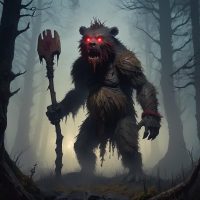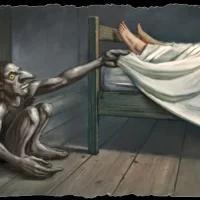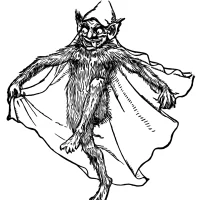Bugbear : The English Boogeyman
Listen
At a glance
| Description | |
|---|---|
| Origin | English Mythology |
| Classification | Spirits |
| Family Members | N/A |
| Region | England |
| Associated With | Death, Scares, Children |
Bugbear
Introduction
The Bugbear is a creature born from English folklore, once feared as a monstrous spirit used to frighten children into good behavior. Its name originates from the Middle English word bugge, meaning a frightening thing, combined with bear, reflecting its supposed bear-like appearance. In medieval times, the Bugbear was imagined as a shaggy, shadowy figure lurking in the woods, waiting to capture the disobedient. Over time, this eerie forest monster evolved beyond nursery tales to become a recognized figure in fantasy fiction, tabletop gaming, and popular culture. From its medieval origins as a symbol of irrational fear, the Bugbear now stands as both a literal and metaphorical representation of the things that haunt human imagination.
Physical Traits
Traditional depictions of Bugbears describe them as hulking, hairy humanoids that resemble a grotesque mix of goblin and bear. Standing roughly seven feet tall, they are muscular and broad-shouldered, covered in thick fur ranging in color from dark brown to yellowish hues. Their facial features combine animalistic and humanoid elements, with a broad snout, sharp fangs, and pointed ears. Their eyes are often said to glow red or green, adding to their terrifying presence in the dark woods. Despite their size, Bugbears are known for their stealth, moving silently through forests and shadowed areas. Their sense of smell and hearing is acute, allowing them to detect intruders long before they are seen. In fantasy settings like Dungeons & Dragons, Bugbears are described as goblinoids with exceptional strength and agility, using crude weapons and armor scavenged from fallen foes. These traits make them effective ambushers and fearsome warriors.
Family
In English folklore, Bugbears were generally solitary figures, existing more as cautionary spirits than as members of any larger group. However, in modern mythology and gaming traditions, they are part of the goblinoid family alongside goblins and hobgoblins. Within this hierarchy, Bugbears are portrayed as the largest and most physically dominant members of their kin. They often live in tribal communities led by the strongest warrior or shaman, following a primitive social order centered on power and survival. In fantasy lore, Bugbears can sometimes be found working alongside goblins or serving under hobgoblin warlords, though their loyalty is often fickle and self-serving. Their society is shaped by hunting, raiding, and territorial dominance, emphasizing might over morality. This evolution from a lone bogeyman to a structured species reflects how folklore adapts when incorporated into modern worldbuilding.
Other Names
The Bugbear shares its roots and purpose with a host of similar creatures across cultures. Its name connects to the Old Welsh word bwg, meaning ghost or goblin, and the Old Scots bogill, meaning mischievous spirit. Over time, the Bugbear became interchangeable with figures like the Bogeyman, Bugaboo, and Boggart—entities used to instill obedience through fear. In different parts of Europe, variations of the Bugbear emerged: the Serbian Bauk, a bear-like creature that hides in dark corners and preys on humans, and the Scottish Bogle, a mischievous but often dangerous household spirit. Even in literature and metaphor, the term “bugbear” has persisted, now used to describe a source of irritation or an ongoing problem. This transformation from supernatural terror to common annoyance illustrates how language and myth evolve side by side, preserving the essence of fear in new forms.
Powers and Abilities
In its earliest folklore appearances, the Bugbear’s power lay not in magic but in its role as a symbol of fear. It was said to hide in forests or under beds, waiting for those who misbehaved or wandered too far at night. However, as the myth entered the realm of fantasy literature and games, its abilities expanded significantly. Modern interpretations grant Bugbears traits such as enhanced strength, night vision, and uncanny stealth. They are described as ambush predators capable of moving silently despite their massive size. In Dungeons & Dragons, Bugbears possess traits like “Surprise Attack,” allowing them to strike swiftly and lethally before their targets can react. Their long limbs grant them extra reach in battle, and their physical resilience makes them formidable opponents. Some fantasy adaptations attribute to them fey ancestry, explaining their stealth and ability to blend into the shadows. Though they are not typically magical creatures, their cunning, agility, and primal ferocity make them natural hunters and warriors feared by adventurers and villagers alike.
Modern Day Influences
The Bugbear has undergone one of the most fascinating transformations in folklore, evolving from a tale of parental warning to a cultural icon in modern fantasy. Its influence is most strongly felt in Dungeons & Dragons, where Bugbears first appeared in the 1975 Greyhawk supplement. Here, they were described as brutal goblin-giants—creatures of stealth and strength. Since then, Bugbears have appeared across nearly every edition of the game, solidifying their place as one of the most recognizable goblinoid monsters in fantasy gaming. Beyond D&D, Bugbears feature in video games such as Baldur’s Gate, Icewind Dale, and The Temple of Elemental Evil, where they often serve as early-game adversaries or tribal enemies lurking in ruins and forests.
Outside of gaming, the Bugbear’s legacy extends into language and culture. In English, “bugbear” remains a common term for a pet peeve or a recurring irritation—a figurative echo of the creature’s original purpose as something that provokes fear or discomfort. The transition from mythic monster to metaphor reveals how the Bugbear has shifted from the supernatural to the psychological, embodying both ancient fears and modern frustrations.
In literature and entertainment, the Bugbear continues to inspire reinterpretations. Fantasy authors often reimagine them as tragic figures, misunderstood beasts living on the fringes of society, while others retain their role as ruthless predators. Their continued presence in games, novels, and even popular idioms highlights their lasting impact. From medieval bedtime stories to high-fantasy adventures, the Bugbear has adapted to each new era while maintaining its core identity—a symbol of lurking menace and hidden dread.
Ultimately, the Bugbear’s enduring popularity demonstrates humanity’s fascination with the creatures that dwell in the shadows. Whether as a monster in a forest, a foe on a game map, or a metaphor for everyday annoyance, the Bugbear remains a powerful reminder of how myths evolve but never truly disappear.
Related Images
Source
Edwards, E. (2013, December 7). Bogles, Bugbears, and Boggarts. Eric Edwards Collected Works. Retrieved from https://ericwedwards.wordpress.com/2013/12/08/bogles-bugbears-and-boggarts/
Greyhawk Online. (2007). Bugbear – Great Library of Greyhawk. Retrieved from https://greyhawkonline.com/greyhawkwiki/Bugbear
Merriam-Webster. (2024, November 12). BUGBEAR Synonyms: 99 Similar and Opposite Words. Retrieved from https://www.merriam-webster.com/thesaurus/bugbear
Monster Wiki – Fandom. (2025, March 9). Bugbear (folklore). Retrieved from https://monster.fandom.com/wiki/Bugbear_(folklore)
Mythology: Gods and Monsters. (2025, April 23). Myth of the Day: Bugbear. Retrieved from https://godsandmonstersinfo.substack.com/p/myth-of-the-day-bugbear
WordHippo. (2009, February 18). What is another word for bugbear? Retrieved from https://www.wordhippo.com/what-is/another-word-for/bugbear.html
DungeonSolvers. (n.d.). D&D Monster Monday: Bugbear. Retrieved from https://www.dungeonsolvers.com/dd-monster-monday-bugbear/
Foefoundry. (2024, December 31). Bugbear Powers. Retrieved from https://foefoundry.com/powers/bugbear/
Frequently Asked Questions
What is lorem Ipsum?
I am text block. Click edit button to change this text. Lorem ipsum dolor sit amet, consectetur adipiscing elit. Ut elit tellus, luctus nec ullamcorper mattis, pulvinar dapibus leo.
What is lorem Ipsum?
I am text block. Click edit button to change this text. Lorem ipsum dolor sit amet, consectetur adipiscing elit. Ut elit tellus, luctus nec ullamcorper mattis, pulvinar dapibus leo.
What is lorem Ipsum?
I am text block. Click edit button to change this text. Lorem ipsum dolor sit amet, consectetur adipiscing elit. Ut elit tellus, luctus nec ullamcorper mattis, pulvinar dapibus leo.
What is lorem Ipsum?
I am text block. Click edit button to change this text. Lorem ipsum dolor sit amet, consectetur adipiscing elit. Ut elit tellus, luctus nec ullamcorper mattis, pulvinar dapibus leo.
What is lorem Ipsum?
I am text block. Click edit button to change this text. Lorem ipsum dolor sit amet, consectetur adipiscing elit. Ut elit tellus, luctus nec ullamcorper mattis, pulvinar dapibus leo.








